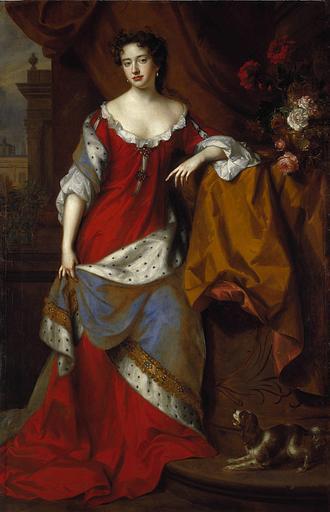MAKE A MEME
View Large Image

| View Original: | Anne,_Queen_of_Great_Britain.jpg (540x839) | |||
| Download: | Original | Medium | Small | Thumb |
| Courtesy of: | commons.wikimedia.org | More Like This | ||
| Keywords: Anne (6 February 1665 – 1 August 1714)[1] became Queen of England, Scotland and Ireland on 8 March 1702, succeeding her brother-in-law, William III of England and II of Scotland. Her Catholic father, James II and VII, was deemed by the English Parliament to have abdicated when he was forced to retreat to France during the Glorious Revolution of 1688/9; her brother-in-law and her sister then became joint monarchs as William III & II and Mary II, the only such case in British history. After Mary's death in 1694, William continued as sole monarch until his own death in 1702. On 1 May 1707, under the Acts of Union 1707, England and Scotland were united as a single sovereign state, the Kingdom of Great Britain. Anne became its first sovereign, while continuing to hold the separate crown of Queen of Ireland and the title of Queen of France. Anne reigned for twelve years until her death in August 1714. Anne was therefore the last Queen of England and the last Queen of Scots. Anne's life was marked by many crises, both personally and relating to succession of the Crown and religious polarisation. Because she died without surviving issue, Anne was the last monarch of the House of Stuart. She was succeeded by her second cousin, George I, of the House of Hanover, who was a descendant of the Stuarts through his maternal grandmother, Elizabeth, daughter of James VI & I. by Michael Dahl,painting,1705 Anne (6 February 1665 – 1 August 1714)[1] became Queen of England, Scotland and Ireland on 8 March 1702, succeeding her brother-in-law, William III of England and II of Scotland. Her Catholic father, James II and VII, was deemed by the English Parliament to have abdicated when he was forced to retreat to France during the Glorious Revolution of 1688/9; her brother-in-law and her sister then became joint monarchs as William III & II and Mary II, the only such case in British history. After Mary's death in 1694, William continued as sole monarch until his own death in 1702. On 1 May 1707, under the Acts of Union 1707, England and Scotland were united as a single sovereign state, the Kingdom of Great Britain. Anne became its first sovereign, while continuing to hold the separate crown of Queen of Ireland and the title of Queen of France. Anne reigned for twelve years until her death in August 1714. Anne was therefore the last Queen of England and the last Queen of Scots. Anne's life was marked by many crises, both personally and relating to succession of the Crown and religious polarisation. Because she died without surviving issue, Anne was the last monarch of the House of Stuart. She was succeeded by her second cousin, George I, of the House of Hanover, who was a descendant of the Stuarts through his maternal grandmother, Elizabeth, daughter of James VI & I. by Michael Dahl,painting,1705 Anne, Queen of Great Britain.jpg Her Highness The Lady Anne the future Queen of Great Britain and Ireland in 1685-6 http //www nationalgalleries org/collection/online_search/4 324/result/0/1738 1685-6 upload 1 January 2009 Willem Wissing and Jan van der Vaart PD-old-100 Portraits of Anne of Great Britain Willem Wissing Jan van der Vaardt 17th-century oil portraits of standing women at full length 17th-century portrait paintings with dogs Portrait paintings of women with dogs Anne (6 February 1665 – 1 August 1714)[1] became Queen of England, Scotland and Ireland on 8 March 1702, succeeding her brother-in-law, William III of England and II of Scotland. Her Catholic father, James II and VII, was deemed by the English Parliament to have abdicated when he was forced to retreat to France during the Glorious Revolution of 1688/9; her brother-in-law and her sister then became joint monarchs as William III & II and Mary II, the only such case in British history. After Mary's death in 1694, William continued as sole monarch until his own death in 1702. On 1 May 1707, under the Acts of Union 1707, England and Scotland were united as a single sovereign state, the Kingdom of Great Britain. Anne became its first sovereign, while continuing to hold the separate crown of Queen of Ireland and the title of Queen of France. Anne reigned for twelve years until her death in August 1714. Anne was therefore the last Queen of England and the last Queen of Scots. Anne's life was marked by many crises, both personally and relating to succession of the Crown and religious polarisation. Because she died without surviving issue, Anne was the last monarch of the House of Stuart. She was succeeded by her second cousin, George I, of the House of Hanover, who was a descendant of the Stuarts through his maternal grandmother, Elizabeth, daughter of James VI & I. by Michael Dahl,painting,1705 | ||||